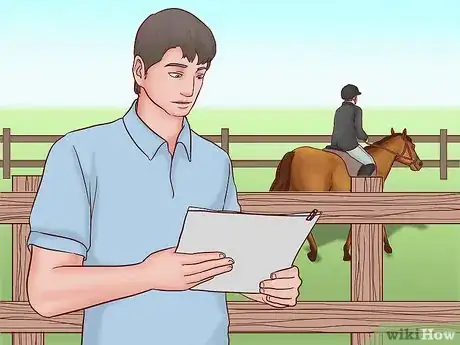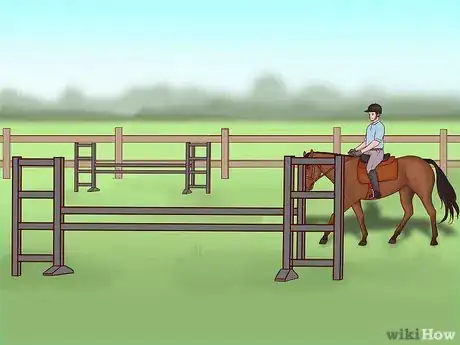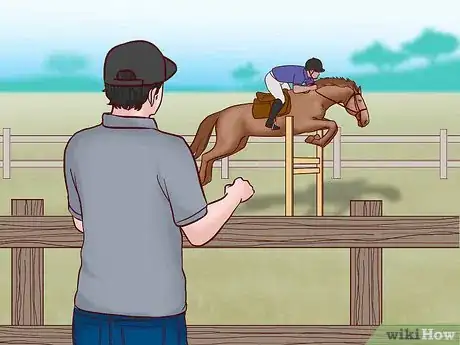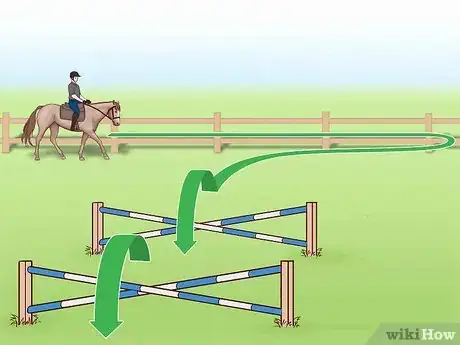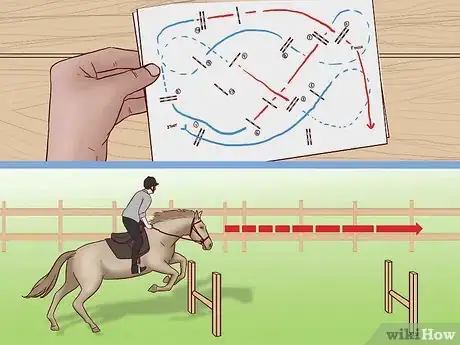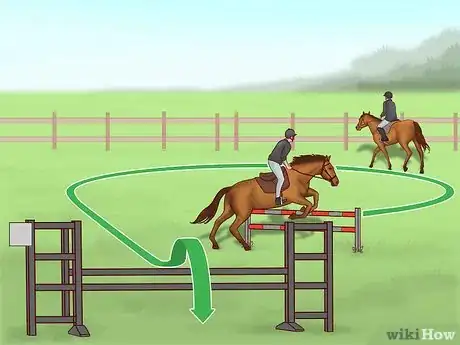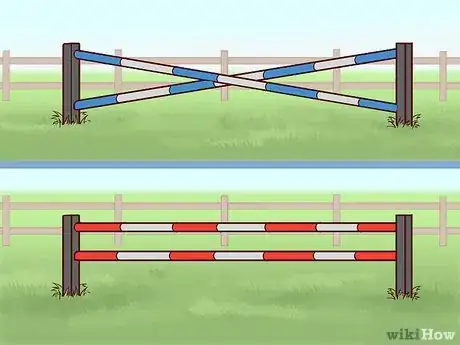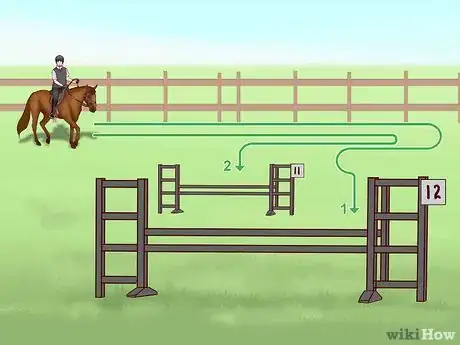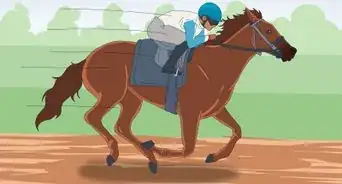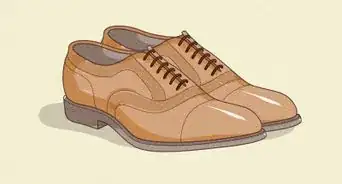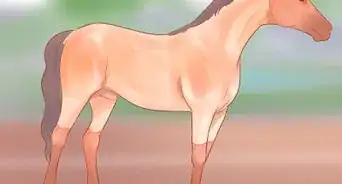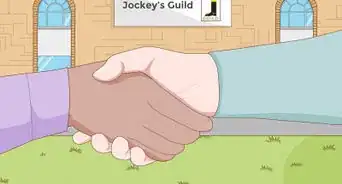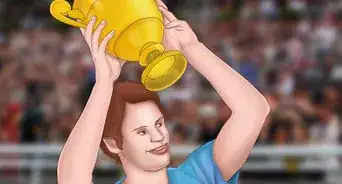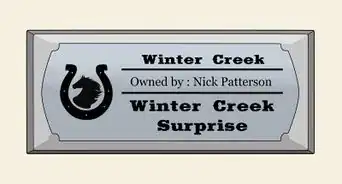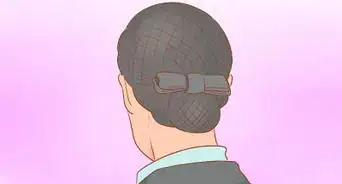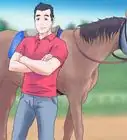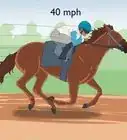This article was co-authored by wikiHow staff writer, Hunter Rising. Hunter Rising is a wikiHow Staff Writer based in Los Angeles. He has more than three years of experience writing for and working with wikiHow. Hunter holds a BFA in Entertainment Design from the University of Wisconsin - Stout and a Minor in English Writing.
This article has been viewed 46,112 times.
Learn more...
Show jumping is a popular equestrian event that challenges both the horse and the rider to quickly go through a course of jumping obstacles. Since many jumping events don’t show the course until the day of the show, it can be difficult to memorize the path you need to take. With careful planning and some easy memorization strategies, you won’t forget the order of the jumps you need to make!
Steps
Plotting and Walking the Course
-
1Take pictures of the course layout. Course layouts are usually released the day of the show jumping event so riders don’t have much time to prepare. Take a picture of the overhead layout that’s posted as well as the actual course. Use the pictures as a reference so you can learn the order of the jumps and how they’re laid out in relation to one another.[1]
- Try to get pictures of the course from as many angles as you can so you can learn it better.
-
2Draw the path you’ll take to hit all of the jumps. Use your finger to trace the path over the picture you took. Follow the numbers and arrows on the obstacles so you know the order you need to complete them in. Refer to the text on the course layout to see what obstacles are included or excluded from your run.[2]
- Look for apps available on Apple or Android, like Jump Off and CourseTool, that allow you to upload the picture of the course layout. Then you can draw the path you’ll run with your finger and save it for future reference.
- Some course layouts may have a dotted line to trace the path you’re supposed to follow while others may not.
Advertisement -
3Say the path you’re taking out loud. While you go over the course, talk yourself through the turns and lines you need to complete. Say them out loud so you have a better chance of remembering them later on. After you’ve gone through the course a few times, look away from the layout and try to recite the path you’re taking from memory.[3]
Tip: Talk to your friends or family while you prepare, and try to explain the course to them. This can help you visualize the course better.
-
4Watch other riders run the jumping course if you can. If you’re lucky, you may have an opportunity to watch other riders go through the course before you. Pay attention to how they make their turns and the obstacles that they’re jumping in order. That way, you can get an idea of how you should plot your path when it’s your turn.[4]
- Sit in different locations so you can see the course ran from all angles.
-
5Walk the course before you have to run it. Before it’s your turn to run the course, you’ll have an opportunity to walk through it at least once. Count your strides so you know how far the obstacles are separated from one another. Then you can plan how you’ll run them while you’re on your horse. As you walk, pay attention to the obstacle numbers and colors so you can remember them when it’s your turn.[5]
- Some events will let you walk through the course multiple times so you can focus on the terrain and other strategies to use to get the fastest time.
- Carry a picture of the course layout with you while you walk it so you can locate the next jumps easily.
Using Memorization Techniques
-
1Find lines between jumps instead of memorizing each one individually. Memorize paths between jumps that are in line with one another rather than trying to remember individual jumps. For example, If you have 2 or 3 jumps in a row, think about the direction you need to go, such as a diagonal line toward the corner. Grouping the jumps together reduces the amount you have to memorize and makes it easier to remember.[6]
- Aim to cut the amount you have to memorize by half. For example, if there are 12 jumps on the course, try to memorize them as 6 paths you need to take.
-
2Use word associations to remember the path you want to take. Think of rhymes or alliterations you can use so you know what movements you need to make as you go through the course. Coming up with clever phrases can help you make an association with the obstacle so it’s easier to recall while you’re making your run.[7]
- For example, you may say something like, “Stay right a smidge after the bridge” to help you remember how to turn your horse or, “Lope left after logs” so you don’t forget to change speeds.
- Put your rhymes to a simple tune so you can recite the lines easily. For example, you could use the tune of “Mary Had a Little Lamb” using your own rhymes.
-
3Remember the colors of the obstacles. Write down the colors of the poles on each jump so you can use them as a memorization device. Rather than trying to remember the individual jumps and numbers, think of their colors in order so you can recall them later on. Without looking at the course, list the colors out loud so you can memorize them.[8]
Tip: You can also use your own color-coding to reference how to ride through specific jumps. For example, you may label jumps red if you need to go slower.
-
4Try working through your route backward. Choose one of the last jumps on the course and recite the path you’re going to take from there. When you reach the end of the course, go back to the jump before the one you started on and run through the course again. This can make it easier to remember the middle of the course rather than always rehearsing from the beginning.[9]
-
5Ask a friend to quiz you on the route you’re going to take. Give the picture of the course to a friend or family member and have them ask you which path you’re taking. Recite the jumps in order using the memorization techniques you’ve used. Have them ask specific questions, like where a certain jump is, so you can memorize the course from any starting point.[10]
Community Q&A
-
QuestionA horse I'll be showing on for the first time can be very headstrong, so I prefer trotting between jumps. Is that allowed in shows? I've mainly see people canter the entire course.
 Community AnswerIt depends on the show. If you are doing hunters, then yes. If you are doing jumpers or stadium jumpers it depends on the pattern. If it is a pinned based on speed, then you want to canter. If it is a power round, trotting is allowed.
Community AnswerIt depends on the show. If you are doing hunters, then yes. If you are doing jumpers or stadium jumpers it depends on the pattern. If it is a pinned based on speed, then you want to canter. If it is a power round, trotting is allowed. -
QuestionI see numbers on the side of the jumps. Is there a show that doesn't let you walk the course?
 Nettie SchulteCommunity AnswerMost of the time they let you walk the course. The numbers are there to help you remember. During the course you will always see the number as you approach the jump.
Nettie SchulteCommunity AnswerMost of the time they let you walk the course. The numbers are there to help you remember. During the course you will always see the number as you approach the jump. -
QuestionHow many jumps are usually in one course?
 Community Answer12- 19 for show jumping, 15 - 25 for cross country.
Community Answer12- 19 for show jumping, 15 - 25 for cross country.
References
- ↑ https://www.theplaidhorse.com/2018/08/28/tips-for-memorizing-your-horse-show-courses/
- ↑ https://hellomylivia.wordpress.com/2016/10/28/6-tips-for-remembering-your-jumper-courses/
- ↑ https://www.theplaidhorse.com/2018/08/28/tips-for-memorizing-your-horse-show-courses/
- ↑ https://www.horsejournals.com/riding-training/english/hunter-jumper/7-tips-memorizing-patterns
- ↑ https://hellomylivia.wordpress.com/2016/10/28/6-tips-for-remembering-your-jumper-courses/
- ↑ https://hellomylivia.wordpress.com/2016/10/28/6-tips-for-remembering-your-jumper-courses/
- ↑ https://www.horsejournals.com/riding-training/english/hunter-jumper/7-tips-memorizing-patterns
- ↑ https://www.theplaidhorse.com/2018/08/28/tips-for-memorizing-your-horse-show-courses/
- ↑ https://www.horsejournals.com/riding-training/english/hunter-jumper/7-tips-memorizing-patterns
